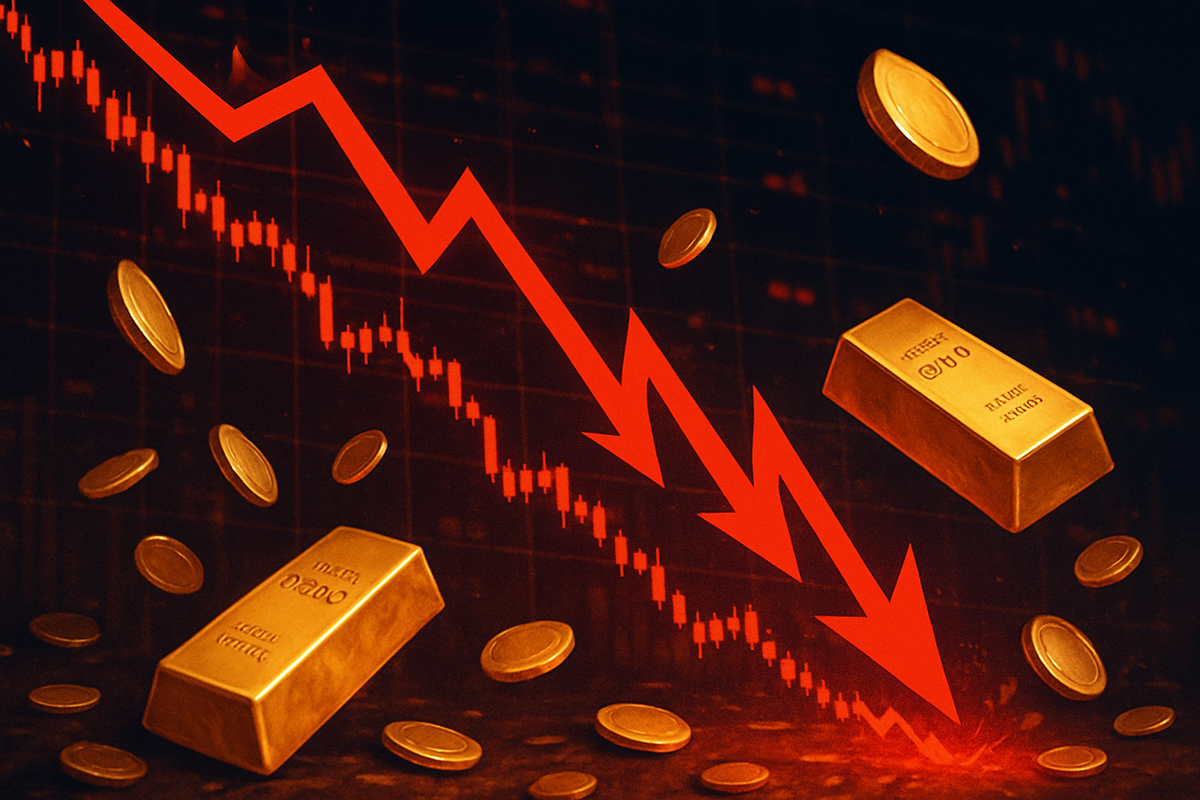
Mumbai, India – October 22, 2025 – The financial markets were rocked today as gold prices experienced a breathtaking plummet, shedding approximately Rs 7,700 per 10 grams in a matter of minutes. This precipitous drop, marking the steepest single-day fall of the year, sent shockwaves through the bullion market and left investors scrambling to understand the sudden and dramatic correction. The unprecedented volatility underscores a significant shift in market dynamics, challenging gold's long-held status as the ultimate safe-haven asset.
The immediate implications are profound, with short-term traders facing substantial losses, while long-term investors cautiously eye a potential buying opportunity. This event is poised to reshape investment strategies and highlight the inherent risks even in traditionally stable commodities.
The Gold Rush Reverses: A Day of Unprecedented Correction
The dramatic decline unfolded on Wednesday, October 22, 2025, just moments after the Multi Commodity Exchange (MCX) opened for its second half of trading. Gold prices, which had recently soared to lifetime highs of Rs 1,32,294 per 10 grams just days prior, crashed by about 6% from Rs 1,28,271 to Rs 1,20,575 per 10 grams within a mere six minutes. This rapid unwinding of value caught many off guard, illustrating the fragility of even seemingly robust market trends.
Several converging factors are being cited as the catalysts for this sharp correction. A significant easing of global geopolitical and trade tensions has diminished gold's traditional appeal as a safe-haven asset. Reports of potential trade agreements and progress in peace talks have shifted market sentiment away from uncertainty, prompting investors to re-evaluate their positions. Furthermore, after gold's recent rally, widespread profit-booking by investors looking to lock in gains intensified the downward pressure. Analysts also point to a reduction in festive demand, particularly in key markets like India, and a strengthening US dollar, which makes dollar-denominated gold more expensive for international buyers, as contributing factors. Technically, the market was deemed "massively stretched" and "overbought," indicating that a correction was due after an extraordinary surge driven by speculative interest and the "fear of missing out" (FOMO) phenomenon.
The immediate market reaction was one of panic and swift repricing. Gold-backed Exchange Traded Funds (ETFs) saw a corresponding drop in value, and the stock prices of gold mining companies faced instant pressure. Silver (MCX: SILVER), often mirroring gold's movements, also experienced a substantial decline, with prices falling by up to 4% in the domestic futures market, dropping below Rs 1,44,000 per kg. Experts are predicting further declines, suggesting gold might test lower support levels as geopolitical risks continue to ease. Investors are now being advised to reassess their portfolios and consider diversification to mitigate potential future losses.
Corporate Fortunes in Flux: Who Wins and Who Loses from Gold's Descent
The sudden and dramatic correction in gold prices has immediately reshaped the landscape for numerous public companies, creating clear winners and losers across the financial ecosystem. The most direct and immediate impact is felt by gold mining companies, whose profitability is intrinsically linked to the price of the yellow metal. High-cost producers, in particular, will face severe profit margin compression, potentially leading to operational cutbacks, project deferrals, or even mine closures. Major players like Newmont (NYSE: NEM), Kinross Gold (TSX: K), Whitten Precious Metal (TSX: WPM), and Agnico Eagle (NYSE: AEM), among others, are likely to see their stock prices under significant pressure as investors re-evaluate their earnings potential. The broader mining equipment and service sectors will also feel the pinch from reduced capital expenditures.
For jewelry retailers, the picture is more nuanced. In the short term, those holding substantial inventory of finished gold jewelry or raw gold purchased at higher prices will face immediate valuation losses, squeezing profit margins. Consumer sentiment could also be negatively affected initially, with buyers adopting a "wait-and-see" approach in anticipation of further price drops. However, in the medium to long term, lower gold prices could stimulate demand, making gold jewelry more affordable and potentially boosting sales volumes. Companies with diversified portfolios, focusing on high-margin studded jewelry or possessing strong brand recognition, such as Titan Company Limited (NSE: TITAN) in India or global luxury brands, may be better positioned to navigate the volatility and even capitalize on increased affordability.
Financial institutions heavily involved in commodity trading, including major banks and hedge funds, are also significantly impacted. Those holding long positions or with large derivative books in gold would have incurred substantial losses due to margin calls and forced selling, potentially exacerbating the price decline. Gold-backed Exchange Traded Funds (ETFs), like the SPDR Gold Shares (NYSEARCA: GLD), will see a direct drop in their net asset value. Conversely, short sellers who had bet against gold or gold mining stocks would have realized significant profits. Some long-term institutional investors might view this sharp decline as a strategic buying opportunity, accumulating gold or related assets at a discount, banking on a future recovery of the precious metal.
A Wider Lens: Gold's Correction in the Global Economic Tapestry
This abrupt gold price correction is not an isolated incident but rather a significant event within broader industry trends, signaling a potential shift in global economic sentiment. The primary driver – easing geopolitical and trade tensions – suggests a move away from the uncertainty that has fueled gold's rally in recent years. As the global economy shows signs of recovery and stability, investors are increasingly pivoting from traditional safe-haven assets towards riskier, growth-oriented investments like equities. This "risk-on" sentiment directly undermines gold's appeal, aligning with a trend where investors seek higher returns in a more predictable economic environment.
The ripple effects of this event extend beyond the immediate gold market. Competitors in the broader investment landscape, particularly equity markets and other industrial commodities, could see increased capital inflows. For instance, if funds are exiting gold, they may flow into sectors perceived to benefit from economic growth, such as technology, industrials, or consumer discretionary. Regulatory bodies might also increase scrutiny on precious metals derivatives markets, especially if the rapid price movement exposed any systemic vulnerabilities or excessive leverage. This could lead to discussions around circuit breakers or stricter margin requirements in commodity exchanges to prevent similar flash crashes.
Historically, sharp corrections in gold prices are not unprecedented. While the speed of this particular drop is notable, gold has experienced significant downturns during periods of perceived global stability or rising interest rates. For example, during the mid-1980s and early 2000s, periods of sustained economic growth and higher real interest rates often coincided with weaker gold performance. More recently, the "taper tantrum" of 2013 saw gold prices fall significantly as the U.S. Federal Reserve signaled a reduction in quantitative easing. These historical precedents suggest that while the current shock is intense, gold markets have demonstrated resilience and eventual recovery, albeit often after prolonged periods of consolidation. The key difference now is the confluence of reduced geopolitical risks, strengthening dollar, and profit-booking, all hitting simultaneously.
What Comes Next: Navigating the Golden Crossroads
The dramatic plunge in gold prices ushers in a period of intense scrutiny and strategic recalibration for investors and companies alike. In the short term, the market is bracing for continued volatility and a consolidation phase, with technical indicators suggesting potential for both temporary dips towards support levels and swift bullish reversals. Experts largely view this correction as a "healthy reset" within an ongoing bull market, rather than a definitive reversal of gold's long-term upward trajectory. However, the path forward will be dictated by the interplay of Federal Reserve policy, the strength of the US dollar, and evolving geopolitical landscapes.
For investors, this juncture presents both challenges and opportunistic entry points. Financial advisors are emphasizing the importance of a rebalanced and diversified portfolio, cautioning against overexposure to any single asset. Long-term investors are being advised to view this correction as an opportunity to accumulate precious metals at more attractive price points, potentially employing a dollar-cost averaging strategy. Focusing on quality assets, such as stronger gold mining companies with robust balance sheets and low production costs, or gold-backed ETFs, will be crucial. Implementing risk management strategies like stop-loss orders and monitoring key economic indicators will be paramount.
Gold mining companies, particularly, face critical strategic pivots. A renewed focus on cost management and operational efficiency will be essential to maintain profitability amidst lower prices. Strengthening balance sheets and implementing robust hedging strategies will mitigate immediate price shock. This period could also catalyze mergers and acquisitions (M&A), as well-capitalized players seek to acquire weaker, highly leveraged competitors, reshaping the industry landscape. Companies with long-life, low-cost reserves will be best positioned to weather the storm and capitalize on future price recoveries. Beyond mining, industries that utilize gold and silver as raw materials, such as electronics, solar, and high-end jewelry manufacturing, could benefit from reduced input costs, enhancing their competitiveness and profit margins.
The Aftermath: A Market Transformed, A Future Redefined
The precipitous drop in gold prices by Rs 7,700 in minutes serves as a stark reminder of the inherent volatility even in traditionally stable assets, prompting a fundamental reassessment of market dynamics. The key takeaway is that gold's safe-haven appeal is directly correlated with global uncertainty; as geopolitical and economic tensions ease, capital tends to flow towards riskier, growth-oriented investments. This event marks a significant inflection point, signaling a potential shift in investor sentiment from fear-driven accumulation to a more discerning approach based on fundamental economic indicators.
Moving forward, the gold market is expected to remain a dynamic and complex arena. While short-term volatility is likely, the long-term outlook for gold remains largely bullish, supported by persistent global economic uncertainties, ongoing central bank demand for diversification, and potential de-dollarization trends. Analysts project gold prices could reach $4,200-$4,400 by the end of 2025 and potentially exceed $5,000 per ounce by mid-2026, albeit with a "volatile climb" rather than a linear ascent. The market is undergoing a necessary "reset," allowing it to build a more sustainable base for future growth.
For investors, the lasting impact of this event will be a renewed emphasis on diversification, risk management, and a nuanced understanding of gold's role within a broader portfolio. This is not the time for panic, but for strategic evaluation. What investors should watch for in the coming months are further communications from central banks regarding monetary policy, the trajectory of real interest rates, sustained trends in the US dollar, and any resurgence of significant geopolitical tensions. These factors will be critical in determining whether gold embarks on a steady recovery or faces a more prolonged period of consolidation. The golden age of easy gains may be over, but the metal's enduring value in a complex global economy remains a compelling narrative.
This content is intended for informational purposes only and is not financial advice







